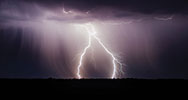

In Africa our supply voltage is 220 VAC @ 50 Hz, it would be ideal if this voltage could be supplied with no variations, but due to the factors listed below, stability in the power feed does not exist.
Modern electronic equipment is designed to tolerate fluctuations in the supply voltage, but mostly only a variation of between 10% and 15% is catered for. When this tolerance is exceeded it starts to eat away at the integrity of your components. Surges cause an even greater increase in voltage across components, the higher voltage in turn supersedes the insulation properties of the electronic components and even the air between connections. This causes the electricity to arc across these points causing permanent damage.
Low voltage, often overlooked, also damages electronics, Ohm’s Law being the silent killer at work here. The lower the supply voltage to your equipment, the larger the amp draw will be, resulting in an increase in heat dissipation. This overheating is a common cause of component deterioration and failure.
Having a bad earth or ground does not directly damage your equipment, but the lack thereof leaves nowhere for the build-up potentials to dissipate to, thus leaving your equipment extremely sensitive to the damage potential of surges.
It is important to look at the major factors in play that cause these variations in our supply: lightning, utility grid switching and the cycling of power on equipment remain the most prominent.

• Lightning – Globally there are 1.4 billion lightning strikes occurring per year as recorded by the Lightning Imaging Sensor aboard NASA’s Tropical Rainfall Measuring Satellite. This high frequency occurrence makes lightning the undisputed number one cause of destructive surges and surge-related failure.
• The voltages in a lightning strike are so high, that the strike does not have to hit the power line or equipment directly to damage it. The EMF induced by a nearby strike generates large voltages that subsequently travel down the supply line destroying equipment until it finds a point to dissipate.
• Utility grid switching – Power is not generated from a single power station but from many locations. The utility company therefore, instead of altering generating equipment operation, switches power across the grid as required. This switching of the power on the grid in turn creates transient surges that flow down the transmission lines.
• Cycling of power on equipment – Surges caused by the intentional or unintentional switching of power to equipment, although the least extreme, is the most frequent cause of surges. These nominal surges damage equipment over a longer period and are less noticeable to the end user.
Fortunately, technology provides us with a couple of tools to deal with the problem.
• Transient Surge Arrestors – This class of surge arrestors function by creating a low impedance path to ground, should the voltage exceed its particular rating. Examples of these are gas arrestor tubes, silicon avalanche diodes and metal oxide varisters.
• Mechanical automatic voltage regulators – These units keeps the voltage supply to your equipment stable by mechanically operating servo motors that increase and decrease the voltage to a buck/boost transformer, keeping the output at a constant voltage.
• Isolation transformers – By utilising an isolation transformer, the equipment has no physical connection to the primary feed. Isolating the connection provides an increased resistance to surges, eliminates ground looping and when used in conjunction with an earth screen, reduces capacitive conducted noise dramatically.
Using these technologies, The Lab has developed its own in-house solution dubbed STEVE, (Surge Technology for Electrical and Video Equipment). Over the years, more than 3000 units have been installed across Africa. Giving us the peace of mind that equipment stability and uptime is never compromised.
Manage what you measure
Measurement is thus the tool, but unfortunately the user of, in this case, security related equipment in Africa, which contrary to belief includes South Africa, is not usually correctly advised. “Lightning or surges damaged your equipment and the warranty does not cover this”, has almost become the norm when it should be the exception.
Cost to own can only be determined and kept to a minimum when a system which comprises of many sub-systems, such as power, becomes part of the design. In so many cases we have seen that proposals from installers would explicitly exclude the power as a condition where the client or end user is to supply these points.
Being certain that your system will last at least till it can be removed from your balance sheet or till the so-called warranty runs out, remains a challenge. This does not mean that the system needs no maintenance, it merely means that if all elements or sub-systems are taken into account during the design, a stable system with very little downtime can be achieved.
What can be done? A client once said to us that his previous service provider was charging him so much every time something goes wrong with his system, either because of a power outage, a surge or lightning, that he calculated he could replace the total system within 24 months. STEVE has been running on his site for 10 years now.
Another was losing thermal cameras along his perimeter every time there was a storm costing him hundreds of thousands of Rand every year. STEVE solved this problem and no failures have occurred over the past three years.
STEVE together with a measured earth has kept systems running throughout Africa for many years but the buck does not stop here.
During the manufacturing process of STEVE, The Lab only uses tried and tested components, measuring the tolerance against set parameters of each batch to ensure that during final test the individual unit is within specification. This test sheet is logged and a copy thereof accompanies the unit to the field. Installation in field is again tested and measured against that specific geographical circumstance. Some alterations / settings are made to bring the field test in line with the Lab test.
A stable supply
An example of this is, because The Lab power supply is stable at 220 VAC (using a voltage regulator) and the field supply could range from 240 VAC (Pretoria) to 210 VAC (Johannesburg) and even 245 VAC (Gabon). The isolation transformer can be altered to lift or drop the mains feed voltage. This is not to say that the isolation transformer will stabilise the power, it brings the mains closer in line with the 220 VAC. These sites thus have a base from which we can work.
City surveillance uses many power sources ranging from traffic light control boxes to overhead lines and distribution boxes in parks. By measuring each of these over a period of time and logging the information against the original test statistics, we can now lift out the bad boys, giving us the information to which we can react before failures occur.
This is true preventative maintenance. STEVE is packaged in many different configurations, but the design and principles remain the same. The Lab has a pole mount version, a rack mount version, a box mount version and even a DB mount version. STEVE can thus be used in any electrical feed ranging from protecting your equipment rack to individual camera locations such as in city surveillance to whole warehouses, such as the anti-retroviral storage warehouses throughout Africa.
Working in cohesion, transient surge arrestors, mechanical automatic voltage regulators, isolation transformers, measured earthing and true preventative maintenance a system’s life cycle and uptime will increase dramatically.
Uptime has many schools of measurement, the fact remains that there are 8760 hours in a year and should a service level agreement dictate a 99% uptime, the system can only be down for 87.6 hours or 3.65 days per year. Is this the case with your system?
For more information contact The Lab SA, +27 (0)12 654 5985, neale@thelabsa.com, www.thelabsa.com

© Technews Publishing (Pty) Ltd. | All Rights Reserved.